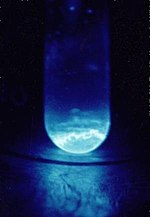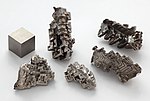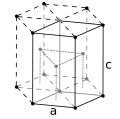Curium(III) nitrate is an inorganic compound, a salt of curium and nitric acid with the chemical formula Cm(NO3)3. Reaction of curium and nitric acid:...
4 KB (299 words) - 13:14, 3 April 2024
Curium is a synthetic chemical element; it has symbol Cm and atomic number 96. This transuranic actinide element was named after eminent scientists Marie...
66 KB (7,817 words) - 07:31, 10 May 2024
Thulium(III) nitrate is an inorganic compound, a salt of thulium and nitric acid with the chemical formula Tm(NO3)3. The compound forms dark-green crystals...
6 KB (376 words) - 12:27, 3 April 2024
Curium(III) oxide is a compound composed of curium and oxygen with the chemical formula Cm2O3. It is a crystalline solid with a unit cell that contains...
16 KB (1,757 words) - 21:42, 22 January 2024
Joaquim Marçalo; John K. Gibson (2018). "Pentavalent Curium, Berkelium, and Californium in Nitrate Complexes: Extending Actinide Chemistry and Oxidation...
5 KB (245 words) - 05:43, 18 January 2024
Californium(III) nitrate is an inorganic compound of californium and iodine with the formula Cf(NO3)3. It can be used as a precursor to other californium...
3 KB (176 words) - 03:46, 29 February 2024
Marçalo, Joaquim; Gibson, John K. (2018). "Pentavalent Curium, Berkelium, and Californium in Nitrate Complexes: Extending Actinide Chemistry and Oxidation...
61 KB (7,452 words) - 01:33, 23 April 2024
range of physical properties. While actinium and the late actinides (from curium onwards) behave similarly to the lanthanides, the elements thorium, protactinium...
130 KB (11,594 words) - 05:53, 24 March 2024
in the transuranic series, it was discovered fourth, after the heavier curium. The discovery was kept secret and only released to the public in November...
77 KB (9,240 words) - 01:04, 19 May 2024
(then the University of California Radiation Laboratory) by bombarding curium with alpha particles (helium-4 ions). It is an actinide element, the sixth...
44 KB (4,609 words) - 14:32, 14 May 2024
Tetramminecopper(II) sulfate – [Cu(NH3)4]SO4 Curium(III) chloride – CmCl3 Curium(III) oxide – Cm2O3 Curium(IV) oxide – CmO2 Curium hydroxide – Cm(OH)3 Cyanogen bromide...
119 KB (8,726 words) - 04:34, 18 April 2024
Chromium (redirect from Chromium(III))
number of chromium(III) compounds are known, such as chromium(III) nitrate, chromium(III) acetate, and chromium(III) oxide. Chromium(III) can be obtained...
99 KB (11,258 words) - 16:12, 19 May 2024
MOX fuel (section Curium content)
mode". This is one means of transmutation. Work with curium is much harder than americium because curium is a neutron emitter, the MOX production line would...
20 KB (2,545 words) - 00:45, 3 February 2024
compounds are used in photographic and X-ray film. Dilute solutions of silver nitrate and other silver compounds are used as disinfectants and microbiocides...
94 KB (11,249 words) - 22:16, 10 April 2024
dissolve gallium, forming gallium(III) salts such as Ga(NO 3) 3 (gallium nitrate). Aqueous solutions of gallium(III) salts contain the hydrated gallium...
74 KB (8,753 words) - 04:32, 21 May 2024
permanganate 7783–98–4 AgN3 silver azide 13863–88–2 AgNO3 silver nitrate 7761–88–8 AgO silver(I,III) oxide 1301–96–8 AgONC silver fulminate 5610–59–3 AgPF6 silver...
139 KB (120 words) - 23:26, 30 April 2024
halides is gadolinium(III) chloride (GdCl3). The oxide dissolves in acids to give the salts, such as gadolinium(III) nitrate. Gadolinium(III), like most lanthanide...
46 KB (5,773 words) - 02:13, 15 May 2024
Copper (redirect from Copper(III))
oxyanions form complexes; these include copper(II) acetate, copper(II) nitrate, and copper(II) carbonate. Copper(II) sulfate forms a blue crystalline...
120 KB (13,743 words) - 16:47, 13 May 2024
CmO is also known. Black CmO2 can be obtained by burning curium oxalate (Cm 2(C 2O 4) 3), nitrate (Cm(NO 3) 3), or hydroxide in pure oxygen. Upon heating...
15 KB (1,742 words) - 03:06, 22 March 2024
neptunium, plutonium, curium and berkelium. Einsteinium(II) compounds can be obtained, for example, by reducing einsteinium(III) with samarium(II) chloride...
68 KB (8,047 words) - 08:55, 16 May 2024
Indium (section Indium(III))
to form tin isotopes. Indium(III) oxide, In2O3, forms when indium metal is burned in air or when the hydroxide or nitrate is heated. In2O3 adopts a structure...
47 KB (5,599 words) - 00:36, 15 May 2024
bismuth(III) sulfate and sulfur dioxide. 6 H2SO4 + 2 Bi → 6 H2O + Bi2(SO4)3 + 3 SO2 It reacts with nitric acid to make bismuth(III) nitrate (which decomposes...
62 KB (7,034 words) - 22:06, 19 May 2024
Marçalo, Joaquim; Gibson, John K. (2018). "Pentavalent Curium, Berkelium, and Californium in Nitrate Complexes: Extending Actinide Chemistry and Oxidation...
46 KB (14,122 words) - 03:24, 16 May 2024
polychalcogenides with cerium(III): cerium(IV) derivatives of S, Se, and Te are unknown. The compound ceric ammonium nitrate ("CAN") (NH4)2[Ce(NO3)6] is...
49 KB (5,785 words) - 06:47, 3 May 2024
Europium (section Eu(II) vs. Eu(III))
conditions. Commonly these compounds feature Eu(III) bound by 6–9 oxygenic ligands. The Eu(III) sulfates, nitrates and chlorides are soluble in water or polar...
43 KB (5,249 words) - 15:15, 15 April 2024
Thallium (section Thallium(III))
Sulfuric and nitric acids dissolve thallium rapidly to make the sulfate and nitrate salts, while hydrochloric acid forms an insoluble thallium(I) chloride...
52 KB (5,782 words) - 09:36, 2 May 2024
which remain in the aqueous phase. The transuranium elements americium and curium also remain in the aqueous phase. The nature of the organic soluble uranium...
12 KB (1,549 words) - 07:46, 6 May 2024
actinides, primarily americium and curium, and the fission products remain in the aqueous phase. The nature of uranyl nitrate complexes with trialkyl phosphates...
13 KB (1,185 words) - 06:41, 6 March 2024
Swedish chemist Carl Gustaf Mosander in 1839 as an impurity in cerium nitrate – hence the name lanthanum, from the ancient Greek λανθάνειν (lanthanein)...
48 KB (6,025 words) - 10:14, 13 May 2024
the early and middle actinides (up to americium, and also expected for curium), thorium forms a cyclooctatetraenide complex: the yellow Th(C8H8)2, thorocene...
136 KB (15,902 words) - 07:42, 19 May 2024























